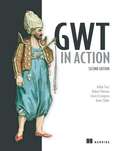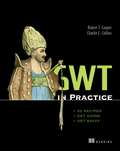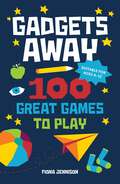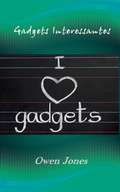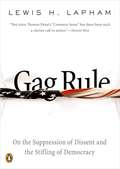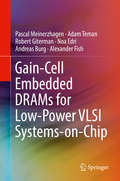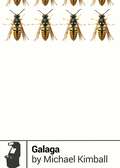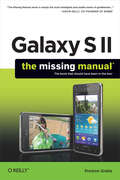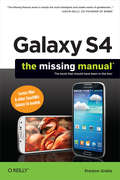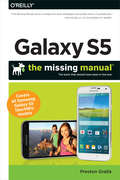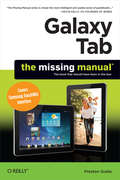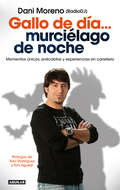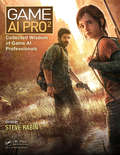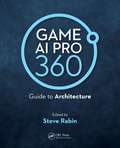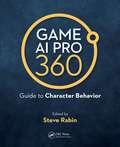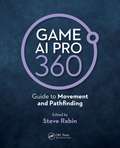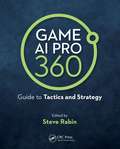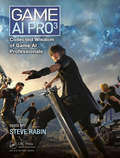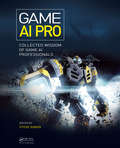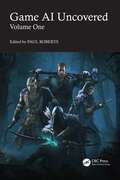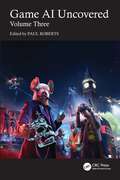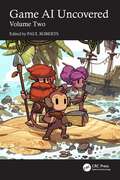- Table View
- List View
GWT in Action
by Robert Hanson Jason Essington Anna Tokke Adam TacySummaryGWT in Action, Second Edition is a completely revised edition of the best-selling GWT book. It covers the new features introduced in GWT 2.4 and 2.5, as well as the best development practices that have emerged in the GWT community. It begins with a rapid-fire introduction to GWT and Ajax to get you up to speed with GWT concepts and tools. Then, you'll explore key concepts like managing events, interacting with the server, creating UI components, building your user interface declaratively using UiBinder ... and more.About the TechnologyGoogle Web Toolkit works on a simple idea. Write your web application in Java, and GWT crosscompiles it into JavaScript. It is open source, supported by Google, and version 2.5 now includes a library of high-quality interface components and productivity tools that make using GWT a snap. The JavaScript it produces is really good.About this BookGWT in Action, Second Edition is a revised edition of the best-selling GWT book. In it, you'll explore key concepts like managing events, interacting with the server, and creating UI components. As you move through its engaging examples, you'll absorb the latest thinking in application design and industry-grade best practices, such as implementing MVP, using dependency injection, and code optimization. Written for Java developers, the book requires no prior knowledge of GWT. Purchase of the print book comes with an offer of a free PDF, ePub, and Kindle eBook from Manning. Also available is all code from the book.What's InsideCovers GWT 2.4 and upEfficient use of large data setsOptimizing with client bundles, deferred binding, and code splittingUsing generators and dependency injectionAbout the AuthorsAdam Tacy and Robert Hanson coauthored the first edition of GWT in Action. Jason Essington is a Java developer and an active contributor to the GWT mailing list and the GWT IRC channel. Anna Tökke is a programmer and solutions architect working with GWT on a daily basis.Table of ContentsPART 1 BASICSGWTBuilding a GWT application: saying "Hello World!"Building a GWT application: enhancing Hello WorldPART 2 NEXT STEPSCreating your own widgetsUsing client bundlesInterface design with UiBinderCommunicating with GWT-RPCUsing RequestFactoryThe Editor frameworkData-presentation (cell) widgetsUsing JSNI—JavaScript Native InterfaceClassic Ajax and HTML formsInternationalization, localization, and accessibilityPART 3 ADVANCEDAdvanced event handling and event bussesBuilding MVP-based applicationsDependency injectionDeferred bindingGeneratorsMetrics and code splitting
GWT in Practice
by Robert Cooper Charlie CollinsIf you're a web developer, you know that you can use Ajax to add rich, user-friendly, dynamic features to your applications. With the Google Web Toolkit (GWT), a new Ajax tool from Google that automatically converts Java to JavaScript, you can build Ajax applications using the Java language.GWT in Practice is an example-driven, code-rich book designed for web developers already familiar with the basics of GWT who now want hands-on experience. After a quick review of GWT fundamentals, GWT in Practice presents scores of handy, reusable solutions to the problems you face when you need to move beyond "Hello World" and "proof of concept" applications. This book skips the theory and looks at the way things really work when you're building. I also shows you where GWT fits into the Enterprise Java Developer's toolset. Written by expert authors Robert Cooper and Charlie Collins, this book combines sharp insight with hard-won experience. Readers will find thorough coverage of all aspects of GWT development from the basic GWT concepts to in depth real world example applications.The first part of the book is a rapid introduction to the GWT methodology The second part of the book then delves into several practical examples which further demonstrate core aspects of the toolkit The book concludes by presenting several larger GWT applications including drag and drop support for UI elements, data binding, processing streaming data, handling application state, automated builds, and continuous integration.Along the way GWT in Practice covers many additional facets of working with the toolkit. Various development tools are used throughout the book, including Eclipse, NetBeans, IDEA, Ant, Maven, and, of course, the old fashioned command line. The book also addresses integrating GWT with existing applications and services along with enterprise and team development.
Gadget Interessanti (Come fare... #28)
by Owen JonesGli articoli presenti in questo ebook sono suggerimenti e consigli su gadget, strumenti interessanti anche per gli adulti e argomenti simili. Tuttavia, il libro dovrebbe essere considerato nella sua totalità. Il testo è composto su diversi livelli: spero che troverai le sue informazioni utili, e inoltre, comprandolo, potrai anche usarne i contenuti nelle tue pubblicazioni.
Gadgets Away: 100 Games To Play With The Family
by Fiona JennisonTechnology has become the too-easy way to entertain ourselves and our children. This easy-to-use, imaginative book has everything. There’s plenty of fun here to keep your family laughing: Sporty games and playground classics Activities for indoors, gardens, parks and beaches Memory and travel games, brain teasers and magic tricks
Gadgets Interessantes (Como fazer... #28)
by Owen JonesGadgets Interessantes Olá e obrigado por comprar este ebook chamado "Gadgets Interessantes". Espero que você ache as informações prestativas, úteis e lucrativas. As informações contidas neste e-book sobre vários tipos de gadgets, brinquedos para adultos e assuntos relacionados estão organizadas em 16 capítulos com cerca de 500 a 600 palavras cada. Espero que seja do interesse de quem gosta de tecnologia moderna e de gadgets. Como um bónus adicional, concedo-lhe a permissão para usar o conteúdo no seu próprio site ou nos seus próprios blogs e newsleters, embora seja melhor se antes você os reescrever com as suas próprias palavras. Você também pode dividir o livro e revender os artigos. De facto, o único direito que você não tem é revender ou doar o livro como ele lhe foi entregue. Se você tiver algum comentário, deixe-o na empresa onde você comprou este livro. Você também encontrará mais livros como este por lá. Agradecemos novamente por adquirir este ebook, Saudações, Owen Jones
Gag Rule: On the Suppression of Dissent and the Stifling of Democracy
by Lewis LaphamLapham issues a call to action in defense of one of our most important liberties--the right to raise our voices against the powers that be and have those voices heard.
Gagner un revenu passif avec Quora et démissionner de votre emploi actuel
by Marcus PfeifferMake passive income with quora and quit your job Gagner un revenu passif avec Quora et démissionner de votre emploi actuel de Marcus Pfeiffer Comment devenir riche en ligne (se faire de l’argent en ligne Livre 1) Guide pour se faire de l’argent en ligne avec Quora Voulez-vous gagner de l'argent en ligne tout en restant dans le confort de votre foyer ? Mais malgré vos heures de dur labeur, vous avez toujours du mal à la fin du mois. Croyez-moi, il y a quelques années, je me trouvais exactement dans la même situation que vous. J’avais visité tous les sites d’internet du monde entier dans l’espoir de comprendre comment gagner de l'argent en ligne. Mais, je n'avais gagné aucun centime. Pire encore, j’étais même arrivé à perdre des sommes monstrueuses dans des cours, des publicités, des sites Web, des livres et de mauvais investissements. Mais heureusement, un jour, je suis tombé sur une méthode qui m'a aidé à gagner un revenu passif. Ne vous méprenez pas, passif ne signifie pas que vous n’aurait aucun travail à faire. Ce que je veux dire par là est qu'une fois que vous avez travaillé dur, l'argent coulera à flot suite à peu d’efforts de votre part. Mais pour y arriver, au début, vous devez consacrer plusieurs heures de travail très acharné. Dans ce livre, je vous expliquerai l'approche que j'ai utilisée pour faire fortune. Et je vous promets que si vous suivez mes instructions, vos efforts seront récompensés.
Gain-Cell Embedded DRAMs for Low-Power VLSI Systems-on-Chip
by Pascal Meinerzhagen Adam Teman Robert Giterman Noa Edri Andreas Burg Alexander FishThis book pioneers the field of gain-cell embedded DRAM (GC-eDRAM) design for low-power VLSI systems-on-chip (SoCs). Novel GC-eDRAMs are specifically designed and optimized for a range of low-power VLSI SoCs, ranging from ultra-low power to power-aware high-performance applications. After a detailed review of prior-art GC-eDRAMs, an analytical retention time distribution model is introduced and validated by silicon measurements, which is key for low-power GC-eDRAM design. The book then investigates supply voltage scaling and near-threshold voltage (NTV) operation of a conventional gain cell (GC), before presenting novel GC circuit and assist techniques for NTV operation, including a 3-transistor full transmission-gate write port, reverse body biasing (RBB), and a replica technique for optimum refresh timing. Next, conventional GC bitcells are evaluated under aggressive technology and voltage scaling (down to the subthreshold domain), before novel bitcells for aggressively scaled CMOS nodes and soft-error tolerance as presented, including a 4-transistor GC with partial internal feedback and a 4-transistor GC with built-in redundancy.
Galaga (Boss Fight Books)
by Michael KimballFor fifteen seconds of one of the highest-grossing films of all time, The Avengers&’ plan to save the world comes to a grinding halt when Tony Stark calls out a low-level member of S.H.I.E.L.D. for playing Galaga on the job. Acclaimed novelist and lifelong Galaga player Michael Kimball knows the compulsion: He&’s set and re-set high scores on Galaga machines all across America. What many call the greatest fixed shooter arcade game in history, Galaga broke the Space Invaders mold with superior graphics, faster firing, bonus rounds, tractor beams, and advanced enemy A.I. Since its 1981 release, Galaga has inspired numerous sequels, bootlegs, hacks, and clones—and some version of Galaga has been released for nearly every gaming platform. Kimball shares his obsession with Galaga through a discussion of the innovative gameplay it introduced (including lots of tips), its extensive cultural legacy (including collectibles, movies, rap songs, drinking games, and sex acts), and how Galaga got Kimball through a difficult childhood--and maybe saved his life.
Galaxy S II: The Missing Manual
by Preston GrallaUnlock the potential of Samsung's Galaxy S II with this jargon-free guide from technology guru Preston Gralla. You’ll quickly learn how to shoot high-res photos and HD video, keep your schedule, stay in touch, and enjoy your favorite media. Every page is packed with illustrations and valuable advice to help you get the most from the smartest phone in town. (Note: This book does not cover the Galaxy S3, Galaxy S4, and later models.)The important stuff you need to know:Get dialed in. Learn your way around the Galaxy S II’s calling and texting features.Go online. Browse the Web, manage email, and download apps with Galaxy S II’s 3G/4G network (or create your own hotspot).Master your media. Shoot and share pictures and video, organize and play your music library—and send it wirelessly to your TV or stereo.Be entertained now. Start watching movies and TV shows while they’re still loading.Explore the world. Get news and weather, find a location, and navigate by GPS.Check your schedule. Use the convenient calendar app, and sync it with your Google and Outlook calendars.Preston Gralla is the author of more than 40 books, including Missing Manuals on Droid X2, Xoom, and Galaxy Tab. He’s the editor of WindowsDevCenter.com and OnDotNet, and a contributing editor to Computerworld.
Galaxy S4: The Missing Manual
by Preston GrallaGalaxy S4 is amazing right out of the box, but if you want to get the most of out your S4 or S4 Mini, start here. With clear instructions and savvy advice from technology expert Preston Gralla, you’ll learn how to go online, play games, listen to music, watch movies & TV, monitor your health, and answer calls with a wave of your hand.The important stuff you need to know:Be connected. Browse the Web, manage email, and download apps through WiFi or S4’s 3G/4G network.Navigate without touch. Use Air Gestures with your hand, or scroll with your eyes using Smart Screen.Find new ways to link up. Chat, videochat, and add photos, video, or entire slideshows to text messages.Get together with Group Play. Play games or share pictures, documents, and music with others nearby.Create amazing images. Shoot and edit photos and videos—and combine images from the front and back cameras.Keep music in the cloud. Use Google Play Music to store and access tunes.Check your schedule. Sync the S4 with your Google and Outlook calendars.
Galaxy S5: The Missing Manual
by Preston GrallaGet the most out of Samsung’s Galaxy S5 smartphone right from the start. With clear instructions from technology expert Preston Gralla, this Missing Manual gives you a guided tour of Samsung's new flagship phone, including great new features such as the fingerprint scanner, heart rate sensor, and Download Booster. You’ll get expert tips and tricks for playing music, calling and texting, shooting photos and videos, and even getting some work done.The important stuff you need to know:Get connected. Browse the Web, manage email, and download apps from Google Play through WiFi or 3G/4G network.Keep in touch. Call, text, chat, videochat, conduct conference calls, and reach out with Facebook and Twitter.Capture and display images. Shoot, edit, show, and share photos, slideshows, and high-definition videos.Play and manage your music. Buy music from Google Play or Amazon and listen to it with Galaxy S5’s Music app.Work anywhere. Access your files, company network, calendar, and contacts—and work with Google Docs.Connect to Google Maps. Use geolocation and turn-by-turn drive directions to find your way.Stay fit with S Health. Use this built-in app to keep track of fitness goals, walking, heart rate, blood pressure, and more.
Galaxy Tab: Covers Samsung TouchWiz Interface (The\missing Manual Ser.)
by Preston GrallaGalaxy Tab lets you work, play, read, and connect on the go, but mastering its TouchWiz interface and finding the best apps can be tricky—unless you have this Missing Manual. Gadget whiz Preston Gralla provides crystal-clear explanations and step-by-step instructions to get you up to speed quickly, whether you have the 3G/4G or Wi-Fi version of this amazing device.The important stuff you need to know:Design your experience. Add interactive widgets and mini-apps to your screen with TouchWiz.Satisfy your appetite. Download thousands of games and apps from the Android Market.Keep in touch. Chat, videochat, check email, and browse the Web.Find your way. View maps, use the GPS, and navigate turn-by-turn.Manage your media. Shoot and view photos and videos; organize and play your music.Stay informed. Read books, newspapers, and magazines.Be productive. Use Google Docs to store and share documents.
Gallo de día murciélago de noche: Momentos únicos, anécdotas y experiencias en carretera
by Toni Aguilar Dani Moreno Xavi RodríguezEl mágico mundo de la radio ¿Quién no se sentiría orgulloso de levantarse un lunes sabiendo que lo que hace puede cambiar la vida de alguien para mejor? Dani Moreno, radioDJ de Máxima FM, pagaría por ir a trabajar cada día a la radio porque no puede vivir sin ella. En Gallo de día# murciélago de noche encontraremos sus veinte años de carrera como locutor y como DJ. Lo que le ha sucedido delante y detrás de un micrófono, en el escenario, en el estudio, durante las entrevistas a personajes famosos, en el backstage, en la producción, en la publicidad, en las cabinas, en los hoteles, durante los viajes, en los programas en directo, de clubbing. Anécdotas y experiencias diurnas y nocturnas, los oyentes, los mejores DJ del mundo y el reconocimiento: el premio Ondas. Un libro divertido repleto de momentos radiofónicos estelares y sesiones de infarto que surge de la pasión por la música, lleno de positivismo y energía, en el que el Gallo Máximo te cuenta cómo se hizo realidadsu sueño. Una experiencia de lectura interactiva en la que los lectores más marchosos pueden disfrutar -a través de códigos QR- de vídeos en exclusiva, videoclips y de los momentos memorables de Dani Moreno.
Gambling Man: The Secret Story of the World's Greatest Disruptor, Masayoshi Son
by Lionel Barber&“The defining account of an era in business history.&” —Evan Osnos, National Book Award–winning author of Age of Ambition The unputdownable first Western biography of SoftBank CEO Masayoshi Son, financial disruptor and personification of the 21st century&’s addiction to instant wealth, from the former editor of the Financial Times. As Wall Street swooned and boomed through the last decade, our livelihoods have—now more than ever—come to rely upon the good sense and risk appetites of a few standout investors. And amidst the BlackRocks, Vanguards, and Berkshire Hathaways stands arguably the most iconoclastic of them all: SoftBank&’s Masayoshi Son. In Gambling Man, the first Western biography of Son, the self-professed unicorn hunter, we go behind the scenes of the world&’s most monied halls of power in New York, Tokyo, Silicon Valley, Saudi Arabia, and beyond to see how Son&’s firm SoftBank has defied conventional wisdom and imposing odds to push global tech and commerce into the future. From the dizzying highs of Uber, DoorDash, and Slack to the epic lows of WeWork and tech-infused dogwalking app Wag Son and SoftBank have been at the center of cutting-edge capitalism&’s absolute peaks and valleys. In the process, Son, son of a pachinko kingpin who grew up in a slum in Japan, has been a hero, a villain, and even a meme-ified hero to the internet tech- and finance-bro set all at once. Based on in-depth research and eye-opening interviews, Gambling Man is an unforgettable character study and alarming true story of twenty-first-century commerce that will stick with you long after you turn the final page.
Game AI Pro 2: Collected Wisdom of Game AI Professionals
by Steven RabinGame AI Pro2: Collected Wisdom of Game AI Professionals presents cutting-edge tips, tricks, and techniques for artificial intelligence (AI) in games, drawn from developers of shipped commercial games as well as some of the best-known academics in the field. It contains knowledge, advice, hard-earned wisdom, and insights gathered from across the com
Game AI Pro 360: Guide to Architecture
by Steve RabinSteve Rabin’s Game AI Pro 360: Guide to Architecture gathers all the cutting-edge information from his previous three Game AI Pro volumes into a convenient single source anthology covering game AI architecture. This volume is complete with articles by leading game AI programmers that further explore modern architecture such as behavior trees and share architectures used in top games such as Final Fantasy XV, the Call of Duty series and the Guild War series. Key Features Provides real-life case studies of game AI in published commercial games Material by top developers and researchers in Game AI Downloadable demos and/or source code available online
Game AI Pro 360: Guide to Character Behavior
by Steve RabinSteve Rabin’s Game AI Pro 360: Guide to Character Behavior gathers all the cutting-edge information from his previous three Game AI Pro volumes into a convenient single source anthology that covers character behavior in game AI. This volume is complete with articles by leading game AI programmers that focus on individual AI behavior such as character interactions, modelling knowledge, efficient simulation, difficulty balancing, and making decisions with case studies from both commercial and indie games. Key Features Provides real-life case studies of game AI in published commercial games Material by top developers and researchers in Game AI Downloadable demos and/or source code available online
Game AI Pro 360: Guide to Movement and Pathfinding
by Steve RabinSteve Rabin’s Game AI Pro 360: Guide to Movement and Pathfinding gathers all the cutting-edge information from his previous three Game AI Pro volumes into a convenient single source anthology covering movement and pathfinding in game AI. This volume is complete with articles by leading game AI programmers that explore better ways to smooth paths, avoid obstacles, and navigate 3D space with cutting-edge techniques. Key Features Provides real-life case studies of game AI in published commercial games Material by top developers and researchers in Game AI Downloadable demos and/or source code available online
Game AI Pro 360: Guide to Tactics and Strategy
by Steve RabinSteve Rabin’s Game AI Pro 360: Guide to Tactics and Strategy gathers all the cutting-edge information from his previous three Game AI Pro volumes into a convenient single source anthology that covers game AI strategy and tactics. This volume is complete with articles by leading game AI programmers that focus largely on combat decisions made in a wide variety of genres such as RTS, RPG, MOBA, strategy and tower defense games. Key Features Provides real-life case studies of game AI in published commercial games Material by top developers and researchers in Game AI Downloadable demos and/or source code available online
Game AI Pro 3: Collected Wisdom of Game AI Professionals
by Steve RabinGame AI Pro3: Collected Wisdom of Game AI Professionals presents state-of-the-art tips, tricks, and techniques drawn from developers of shipped commercial games as well as some of the best-known academics in the field. This book acts as a toolbox of proven techniques coupled with the newest advances in game AI. These techniques can be applied to almost any game and include topics such as behavior trees, utility theory, path planning, character behavior, and tactical reasoning. KEY FEATURES Contains 42 chapters from 50 of the game industry’s top developers and researchers. Provides real-life case studies of game AI in published commercial games. Covers a wide range of AI in games, with topics applicable to almost any game. Includes downloadable demos and/or source code, available at http://www.gameaipro.com SECTION EDITORS Neil Kirby General Wisdom Alex Champandard Architecture Nathan Sturtevant Movement and Pathfinding Damian Isla Character Behavior Kevin Dill Tactics and Strategy; Odds and Ends
Game AI Pro: Collected Wisdom of Game AI Professionals
by Steven RabinSuccessful games merge art and technology in truly unique ways. Fused under tight production deadlines and strict performance requirements, shaped by demanding player expectations, games are among the most complex software projects created today. Game AI Pro: Collected Wisdom of Game AI Professionals covers both the art and the technology of game A
Game AI Uncovered: Volume One
by Paul RobertsGame AI Uncovered: Volume One kicks off a brand-new series of books that focus on the development of artificial intelligence in video games. This volume brings together the collected wisdom, ideas, tricks, and cutting-edge techniques from 20 of the top game AI professionals and researchers from around the world. The techniques discussed in these pages cover the underlying development of a wide array of published titles, including Hood: Outlaws and Legends, The Escapists 2, Sackboy: A Big Adventure, Call of Duty: Strike Team, GTI+ Club, Split/Second, Sonic All Stars Racing Transformed, Luna Abyss, Medal of Honor Heroes I & II, Age of Empires IV, Watch Dogs, Battlefield 2042, Plants vs. Zombies: Battle for Neighborville, Dead Space, and more. Contained within this volume are overviews and insight covering a host of different areas within game AI, including situational awareness, pathfinding, tethering, squad behaviours, coordination, auto-generating navigation link data, fluid movement, combining behaviour and animation systems, pedal control for cars, tactical positioning, level of detail, infinite axis utility systems, hierarchical state machines, bots for testing, reactive behaviour trees, and more. Beginners to the area of game AI, along with professional developers, will find a wealth of knowledge that will not only help in the development of your own games but will also spark ideas for new approaches. This volume includes chapters written by Andy Brown, Dr Allan Bruce, Richard Bull, Laurent Couvidou, Steven Dalton, Michele Ermacora, Jonas Gillberg, Dale Green, Johan Holthausen, Dr Aitor Santamaría Ibirika, Dr Nic Melder, Sarat Rallabandi, Bruno Rebaque, John Reynolds, Paul Roberts, David Rogers, Andrea Schiel, Huw Talliss, Dr Tommy Thompson, and David Wooldridge. .
Game AI Uncovered: Volume Three
by Paul Roberts Nicholas DentGame AI Uncovered: Volume Three continues the series with another collection of chapters from 18 of the top game AI professionals and researchers, from around the world. Each chapter includes wisdom, ideas, tips, and tricks that were used in the development of video games.The techniques discussed in these pages cover the underlying development of a wide array of published titles, including Watch Dogs: Legion, City of Gangsters, Eve: Valkyrie, Firefall, The Persistence, Advance Soccer, Alpha Beta Gunner, and Luna Abyss.Contained within this volume are insights that cover a host of different areas within game AI, including vehicle AI, simulating social norms, AI spawning fundamentals, pathfinding, creation of characters using components, animation‑driven behaviour, tactical positioning in football, automated testing, abstract pattern matching, and machine learning for games.Beginners in the area of game AI, along with professional developers, will find a wealth of knowledge that will not only help in the development of their own games but also spark ideas for new approaches.This volume includes chapters written by Dr Allan Bruce, Anubha Banerjee, Bruno Rebaque, Dale Green, David Wooldridge, Eric S. Le Saux, Greg Irwin, Jason Lok Heng Chin, Johan Holthausen, John Reynolds, Mathias Siemonsmeier, Michele Condò, Dr Nic Melder, Paul Roberts, Phil Carlisle, Richard Bull, Robert Zubek, and Tobias Karlsson.
Game AI Uncovered: Volume Two
by Paul Roberts Nicholas DentGame AI Uncovered: Volume Two continues the series with the collected wisdom, ideas, tricks and cutting‑edge techniques from 22 of the top game AI professionals and researchers from around the world.The techniques discussed in these pages cover the underlying development of a wide array of published titles, including The Survivalists, Wheelman, Plants vs. Zombies: Battle for Neighborville, Dead Space, Zombie Army 4, Evil Genius 2, Sniper Elite 5, Sonic & All‑Stars Racing Transformed, DiRT: Showdown, and more.Contained within this volume are overviews and insights covering a host of different areas within game AI, including generalised planners, player imitation, awareness, dynamic behaviour trees, decision‑making architectures, agent learning for automated playthroughs, utility systems, machine learning for cinematography, directed acyclic graphs, environment steering, difficulty scenarios, environmental cues through voxels, automated testing approaches, dumbing down your AI, synchronized path following, and much more.Beginners to the area of game AI, along with professional developers, will find a wealth of knowledge that will not only help in the development of your own games but also spark ideas for new approaches.This volume includes chapters written by Nuno Vicente Barreto, Steve Bilton, Andy Brown, Dr Allan Bruce, Richard Bull, Phil Carlisle, Sarah Cook, Michele Condò, Steven Dalton, Rodolfo Fava, Jonas Gillberg, Dominik Gotojuch, Dale Green, Tobias Karlsson, Jonathan Keslake, Fernando Penousal Machado, Ivan Mateev, Dr Nic Melder, Dr Bram Ridder, Paul Roberts, Licínio Roque, and Andrea Schiel.
